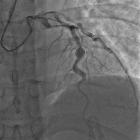coronary artery aneurysm



















Coronary artery aneurysms are an uncommon, predominantly incidental finding.
Epidemiology
Coronary artery aneurysms are most common in men , likely reflecting the increased rates of atherosclerosis in men compared to women. Prevalence varies in the literature between 0.1-5% .
Clinical presentation
Most coronary artery aneurysms are asymptomatic. They can be associated with cardiac murmurs or present with chest pain or congestive cardiac failure.
Pathology
Coronary artery aneurysms are defined as a focal dilatation of the coronary artery by at least 50% compared to a nearby artery or adjacent arterial segment and involve <50% of the artery length . They can be classified by :
- type: true or false aneurysms
- shape: saccular or fusiform
- etiology (see below)
The term coronary artery ectasia is applied when there is dilatation but it involves >50% of the artery length . The subtype, giant coronary artery aneurysms, measure > 2 cm in diameter. In some literature, a coronary artery aneurysm is labeled as "giant" if its size exceeds 5 cm .
Etiology
Pathologically, coronary artery aneurysms can be classified into three groups :
- atherosclerotic
- most common (50%)
- inflammatory
- vasculitis, e.g. Kawasaki disease
- mycotic, e.g. syphilis
- non-inflammatory
- congenital (~17%)
- connective tissue disorders, e.g. systemic lupus erythematosus
- trauma
- iatrogenic, e.g. stent placement
- drug-related, e.g. cocaine abuse
Associations
Coronary artery aneurysms may be associated with coronary arteriovenous fistulas to either cardiac veins or cardiac chambers.
Radiographic features
Imaging modalities used in evaluating coronary artery aneurysms include transthoracic echocardiography, ECG-gated CT angiography, MRI and/or MR angiography, and angiographic cardiac catheterization.
Role of imaging
- depiction of coronary artery anatomy
- detection of coronary artery aneurysms
- evaluation of aneurysm shape and structure:
- morphology (fusiform or saccular)
- aneurysm diameter
- wall calcification
- luminal thrombosis
- presence of associated stenosis
- origin and termination
- monitoring of growth rate
- exclude potential complications:
- myocardial perfusion abnormalities
- fistula formation
- extrinsic mass compression
- rupture and hemopericardium
Treatment and prognosis
There is no established treatment for coronary artery aneurysms with medical and surgical options available . The five-year survival of coronary artery aneurysms is ~70% .
Differential diagnosis
The differential diagnosis includes:
- sinus of Valsalva aneurysm
- aneurysm of a surgically placed coronary arterial or venous graft
- neoplasms of the heart, pericardium, or mediastinum
See also
Siehe auch:
- Polyarteriitis nodosa
- Ehlers-Danlos syndrome
- Marfan-Syndrom
- Takayasu-Arteriitis
- Kawasaki-Syndrom
- syphilitische Aortitis
- kongenitale Fistelungen Koronararterien
- coronary arteries normal diameter
- Aneurysma in aortokoronarem Bypass
- Aneurysma spurium der Koronararterien
- Fibromuskuläre Dysplasie der Koronarien
und weiter:

 Assoziationen und Differentialdiagnosen zu Aneurysma Koronararterien:
Assoziationen und Differentialdiagnosen zu Aneurysma Koronararterien:






